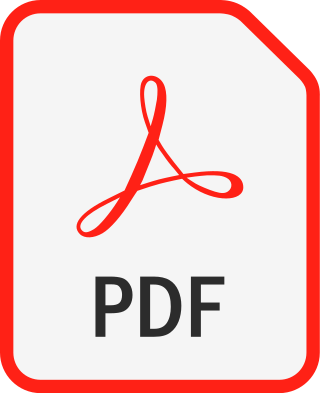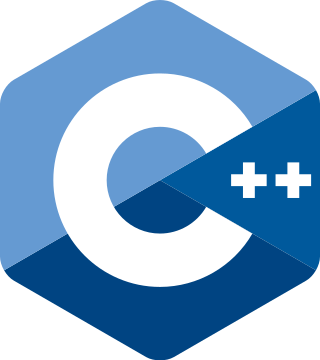
Portable Document Format (PDF), standardized as ISO 32000, is a file format developed by Adobe in 1992 to present documents, including text formatting and images, in a manner independent of application software, hardware, and operating systems. Based on the PostScript language, each PDF file encapsulates a complete description of a fixed-layout flat document, including the text, fonts, vector graphics, raster images and other information needed to display it. PDF has its roots in "The Camelot Project" initiated by Adobe co-founder John Warnock in 1991. PDF was standardized as ISO 32000 in 2008. The last edition as ISO 32000-2:2020 was published in December 2020.
Mathematical Markup Language (MathML) is a mathematical markup language, an application of XML for describing mathematical notations and capturing both its structure and content, and is one of a number of mathematical markup languages. Its aim is to natively integrate mathematical formulae into World Wide Web pages and other documents. It is part of HTML5 and standardised by ISO/IEC since 2015.

C++ is a high-level, general-purpose programming language created by Danish computer scientist Bjarne Stroustrup. First released in 1985 as an extension of the C programming language, it has since expanded significantly over time; as of 1997, C++ has object-oriented, generic, and functional features, in addition to facilities for low-level memory manipulation for systems like microcomputers or to make operating systems like Linux or Windows. It is usually implemented as a compiled language, and many vendors provide C++ compilers, including the Free Software Foundation, LLVM, Microsoft, Intel, Embarcadero, Oracle, and IBM.
Tag Image File Format or Tagged Image File Format, commonly known by the abbreviations TIFF or TIF, is an image file format for storing raster graphics images, popular among graphic artists, the publishing industry, and photographers. TIFF is widely supported by scanning, faxing, word processing, optical character recognition, image manipulation, desktop publishing, and page-layout applications. The format was created by the Aldus Corporation for use in desktop publishing. It published the latest version 6.0 in 1992, subsequently updated with an Adobe Systems copyright after the latter acquired Aldus in 1994. Several Aldus or Adobe technical notes have been published with minor extensions to the format, and several specifications have been based on TIFF 6.0, including TIFF/EP, TIFF/IT, TIFF-F and TIFF-FX.

The Geography Markup Language (GML) is the XML grammar defined by the Open Geospatial Consortium (OGC) to express geographical features. GML serves as a modeling language for geographic systems as well as an open interchange format for geographic transactions on the Internet. Key to GML's utility is its ability to integrate all forms of geographic information, including not only conventional "vector" or discrete objects, but coverages and sensor data.
In computer science Language of Temporal Ordering Specification (LOTOS) is a formal specification language based on temporal ordering of events. LOTOS is used for communications protocol specification in International Organization for Standardization (ISO) Open Systems Interconnection model (OSI) standards.
JSON is an open standard file format and data interchange format that uses human-readable text to store and transmit data objects consisting of name–value pairs and arrays. It is a commonly used data format with diverse uses in electronic data interchange, including that of web applications with servers.
James Pustejovsky is an American computer scientist. He is the TJX Feldberg professor of computer science at Brandeis University in Waltham, Massachusetts, United States. His expertise includes theoretical and computational modeling of language, specifically: Computational linguistics, Lexical semantics, Knowledge representation, temporal and spatial reasoning and Extraction. His main topics of research are Natural language processing generally, and in particular, the computational analysis of linguistic meaning. He holds a B.S. from MIT as well as a PhD from the University of Massachusetts, Amherst.
Office Open XML is a zipped, XML-based file format developed by Microsoft for representing spreadsheets, charts, presentations and word processing documents. Ecma International standardized the initial version as ECMA-376. ISO and IEC standardized later versions as ISO/IEC 29500.
Classification Markup Language (ClaML) is an XML data format specification meant for the exchange of medical classifications, which are code numbers for of medical diagnoses and procedures.
Geospatial metadata is a type of metadata applicable to geographic data and information. Such objects may be stored in a geographic information system (GIS) or may simply be documents, data-sets, images or other objects, services, or related items that exist in some other native environment but whose features may be appropriate to describe in a (geographic) metadata catalog.

ISO/TC 37 is a technical committee within the International Organization for Standardization (ISO) that prepares standards and other documents concerning methodology and principles for terminology and language resources.
A specification often refers to a set of documented requirements to be satisfied by a material, design, product, or service. A specification is often a type of technical standard.
Language resource management – Lexical markup framework, produced by ISO/TC 37, is the ISO standard for natural language processing (NLP) and machine-readable dictionary (MRD) lexicons. The scope is standardization of principles and methods relating to language resources in the contexts of multilingual communication.
The Office Open XML file formats are a set of file formats that can be used to represent electronic office documents. There are formats for word processing documents, spreadsheets and presentations as well as specific formats for material such as mathematical formulas, graphics, bibliographies etc.
TimeML is a set of rules for encoding documents electronically. It is defined in the TimeML Specification version 1.2.1 developed by several efforts, led in large part by the Laboratory for Linguistics and Computation at Brandeis University.
SQL:2011 or ISO/IEC 9075:2011 is the seventh revision of the ISO (1987) and ANSI (1986) standard for the SQL database query language. It was formally adopted in December 2011. The standard consists of 9 parts which are described in detail in SQL. The next version is SQL:2016.
The following outline is provided as an overview of and topical guide to C++:
Temporal annotation is the study of how to automatically add semantic information regarding time to natural language documents. It plays a role in natural language processing and computational linguistics.

